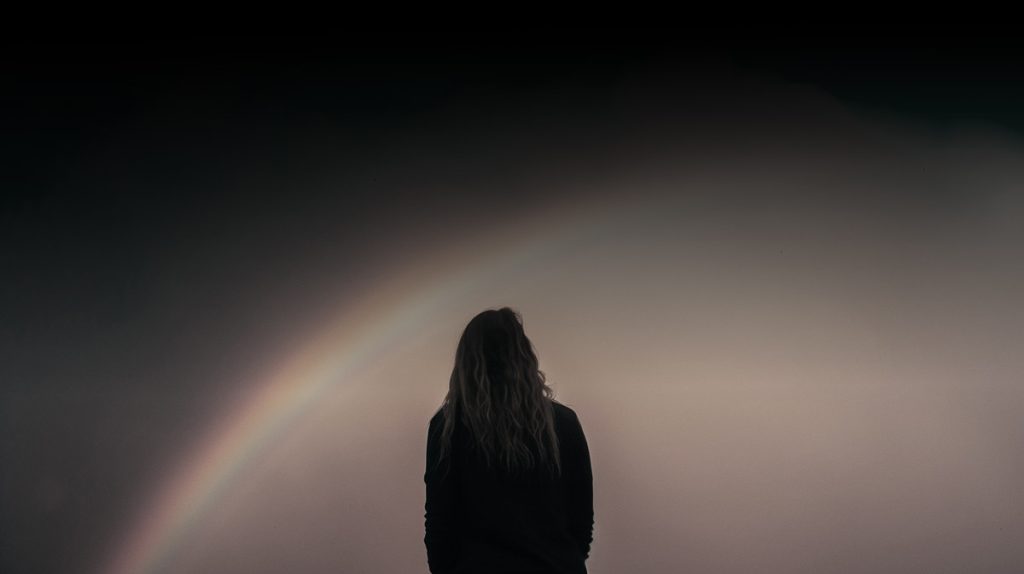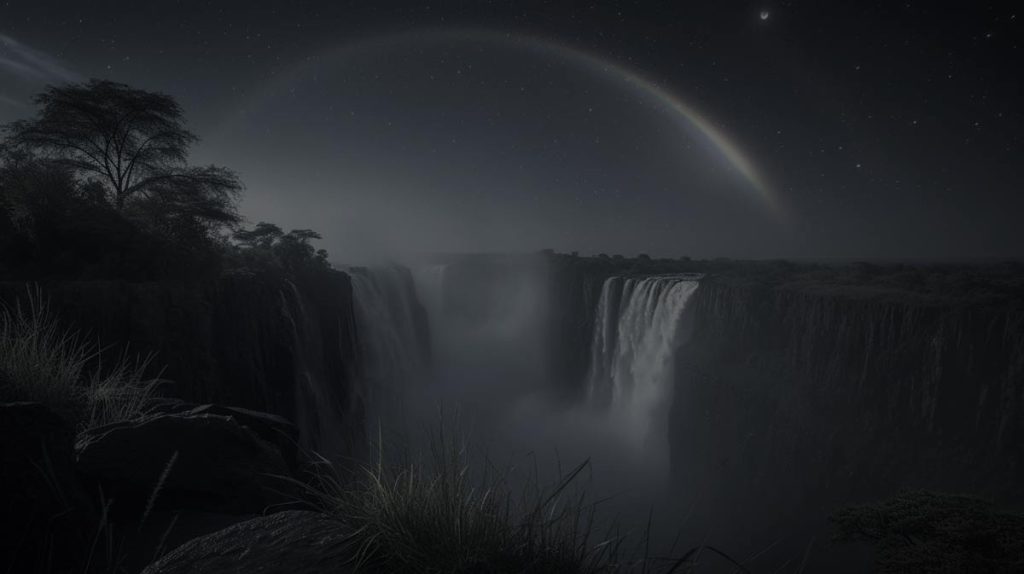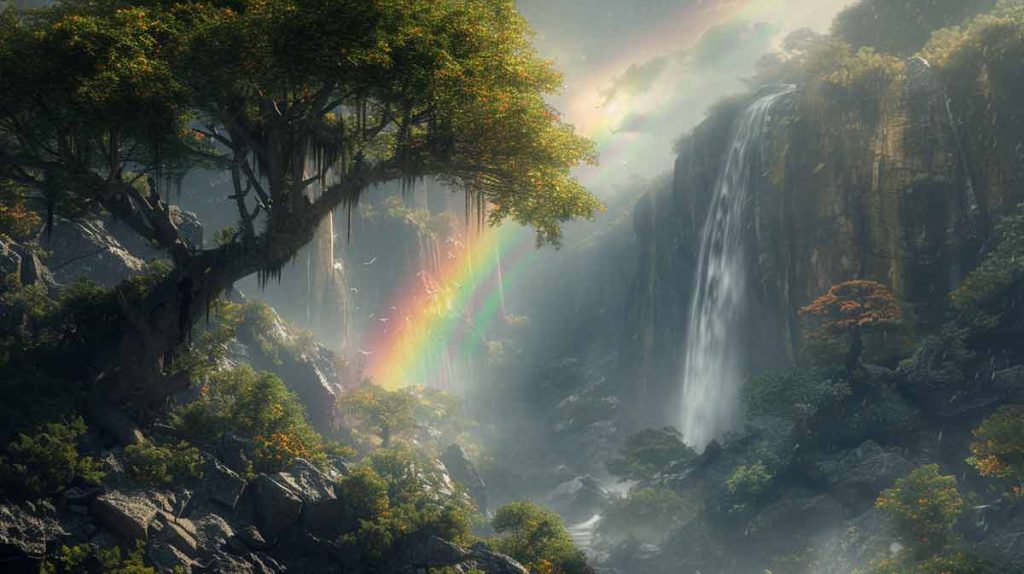As an avid traveller and explorer, I’ve been fortunate enough to witness some of the most awe-inspiring natural phenomena globally. Among these, the elusive and enchanting moonbow, or lunar rainbow, has always held a special place in my heart. In this guide, I’ll take you through a visual journey of understanding and appreciating the rare beauty of moonbows.

What is a Moonbow: The Rare Phenomenon Explained
A moonbow is one of nature’s most ethereal spectacles. Often described as a nighttime rainbow, it’s essentially a rainbow produced by light reflected off the moon’s surface rather than from direct sunlight. This phenomenon is so rare because it requires a unique set of conditions: a nearly full moon, moisture in the air in the form of rain or mist, and a night sky.
Unlike the vibrant hues of a solar rainbow, a moonbow often appears faint and is typically white to the human eye. This is due to the smaller amount of light from the moon and the limited ability of our cone colour receptors to discern colours under low light conditions.
Understanding the Moonbow Phenomenon
To understand why moonbows are rarer than rainbows, consider the amount of light they require. While sunlight is abundant and bright enough to create vivid rainbows, moonlight is much fainter. For a moonbow to form, the moon must be low in the sky (about 42 degrees or less); opposite the moon is an explicit part of the sky where the rain is falling, and the sky must be very dark, usually hours after sunset or before sunrise. These conditions limit the frequency and locations where moonbows can occur.
How Moonbows are Created: The Role of Lunar Light
The creation of a moonbow is a beautiful interplay of light and water. Moonbows are produced by moonlight, reflected sunlight, and refracted through water droplets. This process is similar to the formation of a solar rainbow. However, the light reflected from the moon is much fainter, resulting in the subtler appearance of moonbows.
In the following sections, we’ll explore the differences between lunar and solar rainbows, explore where you can witness this rare natural spectacle, and offer tips on capturing its beauty through photography. Stay tuned as we continue to explore the magical world of moonbows!
Differential Between Lunar and Solar Rainbow
Exploring the differences between a lunar rainbow and a solar rainbow is fascinating. While both phenomena result from the refraction, reflection, and dispersion of light in water droplets, the light source creates distinct differences. Solar rainbows are formed by direct sunlight and are known for their vivid spectrum of colours visible to the human eye. In contrast, moonbows, created by the much fainter moonlight, often appear whitish and are much fainter.
The intensity of the light plays a crucial role here. Sunlight provides much more light, making the colours in a solar rainbow distinctly visible. On the other hand, the light from the moon is a reflected and refracted fraction of sunlight, leading to a less intense and often monochromatic appearance of moonbows.

Moonbows: Rarer than Rainbows?
The rarity of moonbows compared to rainbows lies in the specific conditions required for their formation. While rainbows are common after rainfall during the day, moonbows require a nearly full moon, clear skies opposite the moon, and specific atmospheric conditions. This combination of factors and the need for a dark environment away from city lights makes moonbows a much rarer and more elusive spectacle.
Why Moonbows Appear White to the Human Eye
Moonbows often appear white to the human eye, which is intriguing. Human vision is less sensitive to colours under low light levels. Moonbows are formed by the relatively dim light of the moon, which is usually not bright enough to excite the cone receptors in the human eye responsible for colour perception. As a result, we often perceive moonbows as white or very pale, uncoloured, bright, vivid colours of the colourtime rainbow.
Moonlight Prism: The Science Behind Moonbows
The science behind moonbows is similar to that of rainbows. It involves light bending (refraction) as it passes through water droplets in the air. The light is then reflected inside the droplet and refracted as it exits. In a moonbow, this light is sourced from the moon, which is reflected sunlight. The angle at which the light is refracted and the size of the water droplets determines the appearance and intensity of the moonbow.
In the upcoming sections, we’ll explore the role of water droplets in the air and decode the colours in a moonbow. We will also explore the best places to witness this mesmerising natural phenomenon worldwide.
The Role of Water Droplets in the Air
Water droplets play a pivotal role in the formation of moonbows. These droplets act as tiny prisms, bending the light from the moon. The size and uniformity of the droplets are critical. Larger droplets produce more precise and vivid moonbows, while smaller droplets produce a more diffused and fainter appearance.
Water droplets in the air, typically from mist or light rain, are essential. The angle of the moon’s light hitting these droplets, combined with the observer’s perspective, determines whether a moonbow becomes visible. This delicate balance of conditions makes witnessing a moonbow rare and memorable.
Decoding the Colors in a Moonbow
Though moonbows often appear white or pale to the human eye, they contain colours. The colours in a moonbow are essentially the same as those in a solar rainbow – red, orange, yellow, green, blue, indigo, and violet. However, the lower intensity of moonlight means these colours are less vibrant and more challenging to discern. Long-exposure photography can sometimes reveal these subtle hues, showcasing the true spectrum of a moonbow.
Light Reflected, Refracted, and Dispersed: The Physics of Moonbows
The physics of moonbows is a captivating interplay of light behaviours – reflection, refraction, and dispersion. The light reflected from the moon’s surface is refracted (bent) when it enters the water droplet, dispersed into its component colours inside the droplet, and then refracted again as it exits. This process results in the formation of a moonbow, with its arc shape mirroring that of a solar rainbow.
Understanding Why Moonbows are Low in the Night Sky
Moonbows are typically observed low in the night sky for a critical reason. For a moonbow to form, the moon must be low in the sky, usually less than 42 degrees above the horizon. This positioning ensures that the refracted light forms an arc opposite the moon, visible to observers on the ground. The lower the moon in the sky, the higher the moonbow will appear.
Next, we’ll explore how a full moon contributes to the brightest moon and where you can witness these fantastic night rainbows worldwide.
How a Full Moon Contributes to the Brightest Moonbows
The moon’s phase plays a significant role in the visibility and brightness of moonbows. A full moon is ideal for moonbow formation, providing the maximum light reflected from the moon’s surface. The increased brightness during a full moon enhances the chances of observing a moonbow, making the colours more discernible, albeit still subtle, than a solar rainbow.
The brightness of the moonbow is directly proportional to the amount of light the moon reflects. A nearly full moon, with its significant illumination, is thus more likely to create a moonbow visible to the naked eye. However, even under these conditions, other factors, such as clear skies and sufficient moisture, are crucial.
Witnessing a Night Rainbow: Where Can You See Moonbows
Moonbows are a global phenomenon but are only visible in a handful of places where conditions are just right. Some of the most renowned moonbow locations include:
- Victoria Falls: Straddling Zambia and Zimbabwe, this massive waterfall is known for its spectacular moonbows, created by the mist from the falls under full moon nights.
- Cumberland Falls: Located in Kentucky, USA, Cumberland Falls is often referred to as the “Niagara of the South” and is famous for its regular moonbow sightings.
- Yosemite National Park: Yosemite Falls creates an ideal backdrop for moonbow formation, especially during the spring when the water flow is at its peak.
- Big Island of Hawaii: The clear skies and misty conditions around the waterfalls on Hawaii’s Big Island create perfect conditions for moonbow sightings.
These locations offer a unique opportunity to witness this rare phenomenon, making them popular destinations for nature enthusiasts and photographers.
In the following sections, we will delve into photographing moonbows, including tips on camera settings and the best times for moonbow photography.
Visualising Moonbows: Photography Tips for a Long Exposure Night Sky
Capturing the elusive beauty of moonbows requires specific photography techniques, particularly long exposure. Long exposure allows more light to enter the camera over a more extended period, essential in low-light conditions like those during moonbow sightings. Here are some tips for capturing these nocturnal rainbows:
The Best Time to Photograph Moonbows
The best time to photograph moonbows is when the moon is at its brightest, typically during a full moon. Ideally, plan your photography sessions for a few hours after sunset or before sunrise when the moon is low in the sky. This positioning enhances the likelihood of moonbow formation and provides a better angle for capturing the phenomenon.
Equipment Required for Effective Moonbow Photography
To photograph moonbows effectively, you’ll need the following:
- A camera is capable of extended exposure settings.
- A sturdy tripod to eliminate camera shake during long exposures.
- A remote shutter release to further reduce the risk of camera movement.
The Role of Long Exposure in Capturing Moonbows
Prolonged exposure is critical in moonbow photography. It allows the camera to gather enough light to capture the faint colours of the moonbow. Experiment with exposure times starting from a few seconds to several minutes, depending on the moon’s brightness and the moonbow’s intensity.
How to Adjust Camera Settings for Moonbow Photography
- Set your camera to manual mode to fully control the exposure settings.
- Use a low ISO setting to minimise noise.
- Choose a wide aperture to allow as much light in as possible.
- Adjust the shutter speed according to the light conditions; longer exposures will be necessary in darker conditions.
Practical Tips for Capturing Moonbows
- Scout your location during the day to find the best angles and compositions.
- Focus manually, as autofocus may struggle in low-light conditions.
- Take multiple shots with different settings to increase your chances of capturing a clear image.
Photographing moonbows is both a challenging and rewarding experience, offering photographers a chance to capture one of nature’s most elusive phenomena.
Next, we will explore the cultural significance and symbolism of moonbows in different cultures.
More than Just Sightseeing: The Cultural Significance of Moonbows
Moonbows have captivated human imagination for centuries, not just as a visual spectacle but also for their cultural and symbolic significance. Across different cultures, moonbows have been seen as mystical symbols and have inspired various myths and folklore.
Symbolism of Moonbows in Different Cultures
In many cultures, moonbows are seen as omens or spiritual signs. For example:
- Native American Culture: Among some Native American tribes, the moonbow is a powerful symbol, often associated with transformation, renewal, and the feminine aspects of nature.
- European Folklore: In European folklore, moonbows have been linked to bridging the earthly and supernatural realms, serving as pathways for celestial beings.
- Asian Traditions: In some Asian cultures, moonbows symbolise harmony and balance, reflecting the yin-yang principle of opposing yet complementary forces.
The Legend of the Moonbow in Native American Culture
In Native American legends, the moonbow often appears as a mystical element in storytelling. It is sometimes portrayed as a bridge between the earthly and spirit worlds, offering a connection to ancestors and the divine.
Moonbows in Literature and Folklore
Moonbows have also been a recurring theme in literature and folklore, often symbolising hope, mystery, and the unattainable. Their rarity and ethereal beauty have inspired poets and writers to use them as metaphors for fleeting moments of beauty and enlightenment.
Astrological Interpretations of Moonbows
In astrology, moonbows are sometimes interpreted as celestial signs indicating change or important events. Their appearance during specific lunar phases is often seen as significant, offering insights into the cosmic alignment and its influence on human affairs.
Moonbows in Art: How Artists Interpret this Natural Phenomenon
The ethereal beauty of moonbows has long inspired artists. In paintings and visual art, moonbows are often depicted as gentle, subtle arcs of light, representing tranquillity, mystery, and the beauty of the night. These artistic interpretations reflect the awe and reverence that moonbows have inspired throughout human history.
The cultural significance of moonbows adds a rich layer of meaning to their visual beauty, making them a subject of fascination not just for photographers and nature enthusiasts but also those interested in mythology, folklore, and the arts.
Moonbows in Art: How Artists Interpret this Natural Phenomenon
The mesmerising allure of moonbows has inspired the art world for centuries. Artists have endeavoured to capture their ethereal beauty, often infusing their works with a sense of mystique and otherworldliness.

Moonbows in paintings and digital art are depicted with subtle, luminous arcs, embodying serenity and the enchanting mystery of the night. These interpretations reflect the deep human connection to the natural world and our perpetual fascination with celestial phenomena.
Whether through realistic representations or abstract renditions, moonbows in art invite viewers to contemplate the natural wonders of our world and the boundless creativity they inspire.
Exploring moonbows in art concludes our comprehensive guide to these rare and beautiful lunar rainbows. From their scientific explanation to their cultural significance and representation in art, moonbows remain one of nature’s most captivating mysteries.
Conclusion: Embracing the Magic of Moonbows at Victoria Falls
As we draw this journey through the enchanting world of moonbows to a close, I cannot help but encourage you to experience the magic firsthand. And what better place to witness this celestial marvel than at Victoria Falls, a moonbow paradise between Zambia and Zimbabwe?
With its awe-inspiring waterfalls and misty ambience, Victoria Falls offers the perfect canvas for the moonbow’s ethereal display. Imagine standing under the African sky, where the mighty Zambezi River cascades into the gorge below, and a moonbow arcs gracefully across the night, painted by the light of a full moon. This experience is not just a visual feast; it’s a moment of profound connection with nature.
Visiting Victoria Falls for its moonbows is more than just sightseeing; it’s an opportunity to immerse yourself in a natural wonder that few places on Earth can offer. It’s a chance to stand where the Earth meets the sky, where lunar magic dances across the water, and where stories, legends, and the sheer beauty of our world come alive under the moonlight.
So, pack your bags, bring your sense of wonder, and prepare for an unforgettable adventure. Whether you’re a photographer, a nature enthusiast, or simply someone searching for life’s extraordinary moments, Victoria Falls awaits to unveil its nocturnal rainbow – the moonbow, a reminder of the planet’s endless wonders.
In the words of an explorer, every journey enriches the soul, and witnessing a moonbow at Victoria Falls is a journey like no other. Embrace the magic, and let the lunar rainbow leave its indelible mark on your heart.
Read More Posts from Our Journal
Unlock the Mysteries of the Africa Jungle
Embark on an epic journey through the Africa jungle, where the wonders of African wildlife and natural habitats await your discovery.
What Do Lions Eat? Discover Their Diet Here!
Uncover the eating habits and diet of lions. Explore what these majestic predators consume and their place in the food chain.
Group of Rhinos: What Are They Called?
Discover what a group of rhinos is called and learn fascinating facts about these majestic animals and their social structures.
Explore Diverse Antelope Types Across Continents
Discover the vast array of antelope types around the world, from the common to the rare, and learn about their unique habitats and behaviours.
Discover a Group of Giraffes: Nature’s Majestic Tower
Explore the enchanting dynamics of a group of giraffes and their unique social behaviours in the wild. Unveil the serenity of giraffe herds.
